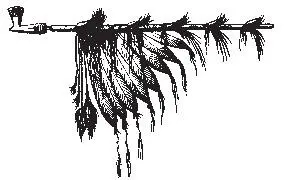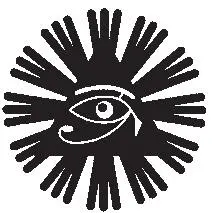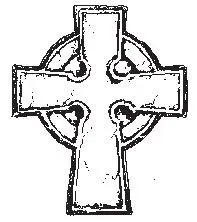Cagliostro’s seal has been the result of much analysis and conjecture, its appearance so convincing that it was even incorporated into an early Masonic-style organization called The Brotherhood of Luxor.

For the Plains Indians, the pipe, also called the calumet, is one of the most important and recognizable symbols. Although it is sometimes referred to as the Peace Pipe, shared ceremonially as part of a unifying ritual, the pipe was just as valid a symbol during times of war.
The tobacco used in the pipe is also a powerful magical substance originally intended for ritual use only. The smoke rising from the pipe signifies a prayer traveling toward the Gods and symbolizes the sacred breath, source of all life. The fire that lights the pipe symbolizes the Sun and the male element. The pipe itself is equivalent to the prayer that is offered up from it.
The calumet is considered so important that in Native American tradition it is described as though it were a person, and each of its components has the name of a body part. In addition, the bowl is described as an altar, and the stem, the passage of the breath extending from the human body.

This is one of the symbolic seals of Aleister Crowley’s Astrum Argentum, or Silver Star order. As the name suggests, it indicates the position of Chancellor. The symbol shows an Eye of Horus at the center of rays that are set in 12 groups of 3.
The Astrum Argentum was started by Crowley in 1907 as an alternative to MacGregor Mathers’ Golden Dawn. Although he had initially been enamored of the Golden Dawn and its charismatic leader, it is fair to say that Crowley liked to do things his own way, resulting in his expulsion from the Golden Dawn. Crowley believed that his own personal angel, Aiwaz, approved of his decision to supplant Mathers’ brotherhood. The unusual structure of the Astrum Argentum was typical of Crowley’s desire to be different. Each member was supposed to know only his immediate superior and anyone he introduced into the Order. For Crowley, the sole purpose of the Astrum Argentum was to disseminate his own teachings and mystical beliefs. It was assumed that anyone introduced into the Astrum Argentum would already have had a great degree of magical training, in contrast to the Golden Dawn, which was dedicated to teaching.
A candle symbolizes light in the darkness in a way that a light-bulb simply cannot do. A candle
represents the element of fire as a benevolent force, made even more powerful if the candle is made of wax, a substance made by a magical creature, the bee. The colors of candles are significant in magical practices: for example, pink is said to attract love. Black candles are used in dark magic.
In understanding symbols, sometimes it is useful to simply look at the shape and see what it resembles. The traditional cauldron represents nothing so much as the belly of a pregnant woman and, unsurprisingly, the cauldron is an important female symbol all over the world. The circular shape of the cauldron gives another clue; the circle is a symbol of never-ending life and regeneration, and these themes recur repeatedly in stories containing cauldron symbolism.
The way the cauldron is used also gives a hint about its symbolic meaning. Things are put into the cauldron, heated, and something different is taken out; the basic ingredients are transformed. Therefore, the cauldron also symbolizes germination and transformation.
Traditionally, cauldrons have three legs. The number 3 in this instance represents the triple aspect of the Great Goddess, or the three fates. Shakespeare alludes to this when the three Weird Sisters—arguably the most famous witches in literature—cook up trouble at the beginning of Macbeth.
In pre-Christian literature, there are countless legends featuring magical cauldrons, and it may be because of this that the cauldron has its witchy associations. Celtic tales tell of cauldrons that contain an unending supply of food or of knowledge. The dead are frequently thrown into a magical Cauldron of Rebirth and climb out the next day, alive once more. Mythical warriors and heroes who died in battle are restored to life in this way. Ceridwen had a cauldron full of inspiration and magical powers. In India, a magic life-giving food, called Soma, was brewed in three huge bottomless cauldrons.
In Greece, there are tales in which an ordeal of initiation involves the person boiling in a cauldron, but after the rite, the initiate emerges with magical powers, including the gift of immortality.
CELTIC CROSS AND SUN CROSS SYMBOL

In the Celtic Cross or Ring Cross symbol, a cross is contained within a circle. Very early versions of this cross, found in Ireland, do not show the arms of the cross protruding beyond the circle; the whole symbol is encompassed inside the circle and in this case it becomes the ancient, universal symbol called the Sun Cross, the Wheel Cross, or Odin’s Cross. This sign first appears at the very start of the Bronze Age. Among other things, it symbolizes the wheel and in China represents thunder, power, and energy. It also appears in the seal of the Babylonian Sun God, Shamash.
The Sun Cross symbol also appears in ancient astrology. In modern astrology it still signifies the planet, and element of, Earth; the cross represents the four corners of the planet, the elements, and the directions, and the circle is the planet itself.
Because it was the symbol of the Sun, the King and the highest temporal and spiritual powers, it was easy for the early Christians to adopt this pagan sign and incorporate it into the Latin Cross. It is still used by Bishops to “bless” a new church, drawn onto the walls in sanctified water or oils, at twelve different places around the church.
The Celtic Cross is frequently used as a grave marker, or as a war memorial, particularly in Celtic countries.
Incidentally, the Hot Cross Bun, eaten specifically at Easter and popularly believed to represent the Christian Cross, is actually of pre-Christian origin. The Greeks, Romans, and Ancient Egyptians all ate wheat cakes to celebrate the coming of spring. These cakes were circular (representing the Moon or Sun) with a cross that divided the cake into the four lunar quarters or the four seasons.
One of the most distinctive decorative features of Celtic artwork and architecture are the beautiful constructions of Celtic knotwork. It adorns stonework, illuminated manuscripts, and jewelry; the knotwork has left a distinctive trail that clearly shows all the places in the world that were visited at some point by the Celts.
The knotwork itself would appear to be a purely decorative device. If at one time there were specific symbolic meanings attached, then these have been lost over the centuries. Intertwining shapes and lines, however, generally point toward ideas of connectedness and the harmonious convergence of opposites, male and female, fire and water, Heaven and Earth, for example. In addition, any sign that can be made without the pen leaving the paper tends to have strong protective associations, and knotwork, with its continual looping and spiraling, could have been used in this way, perhaps used for amulets and talismans.
Читать дальше















